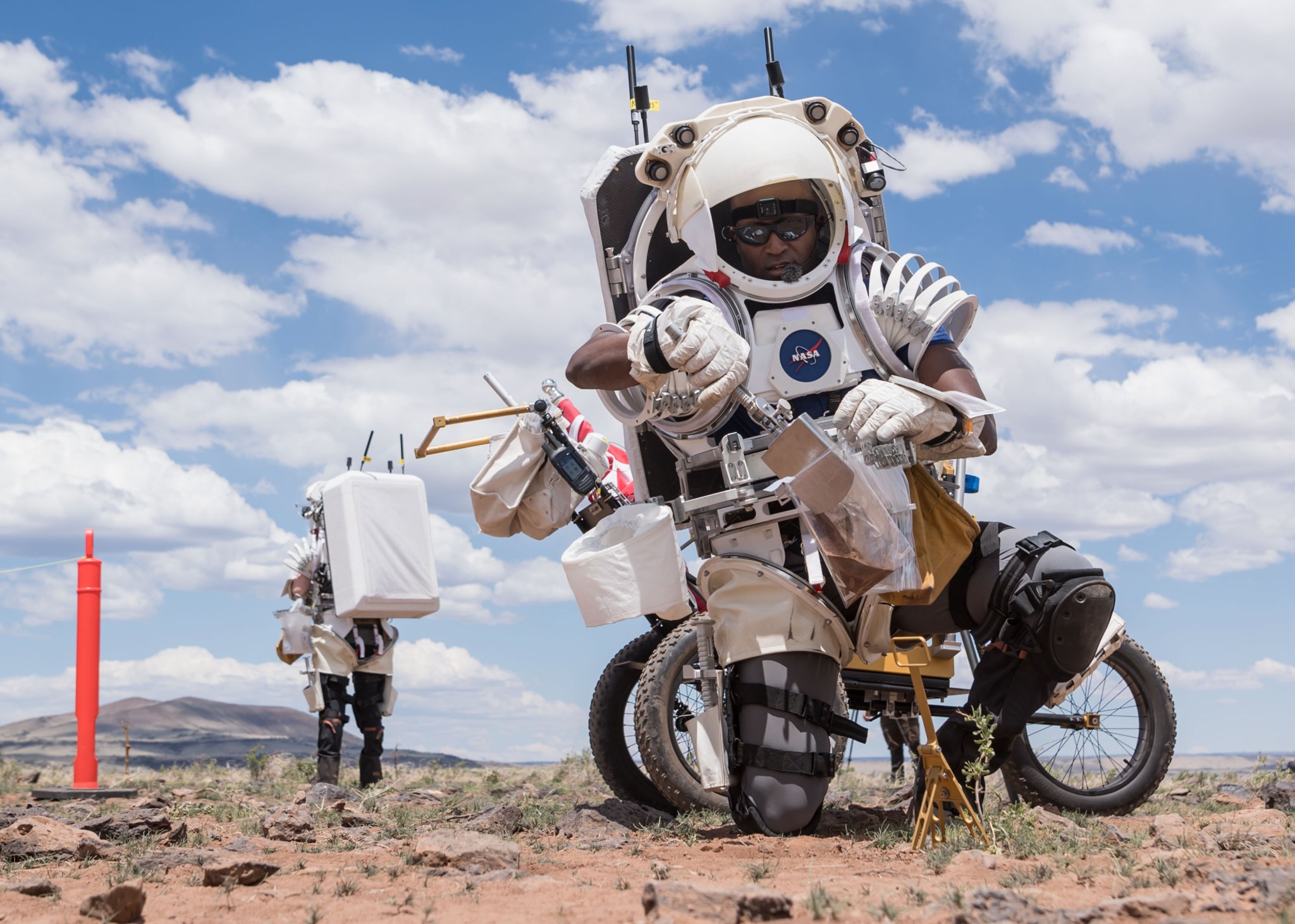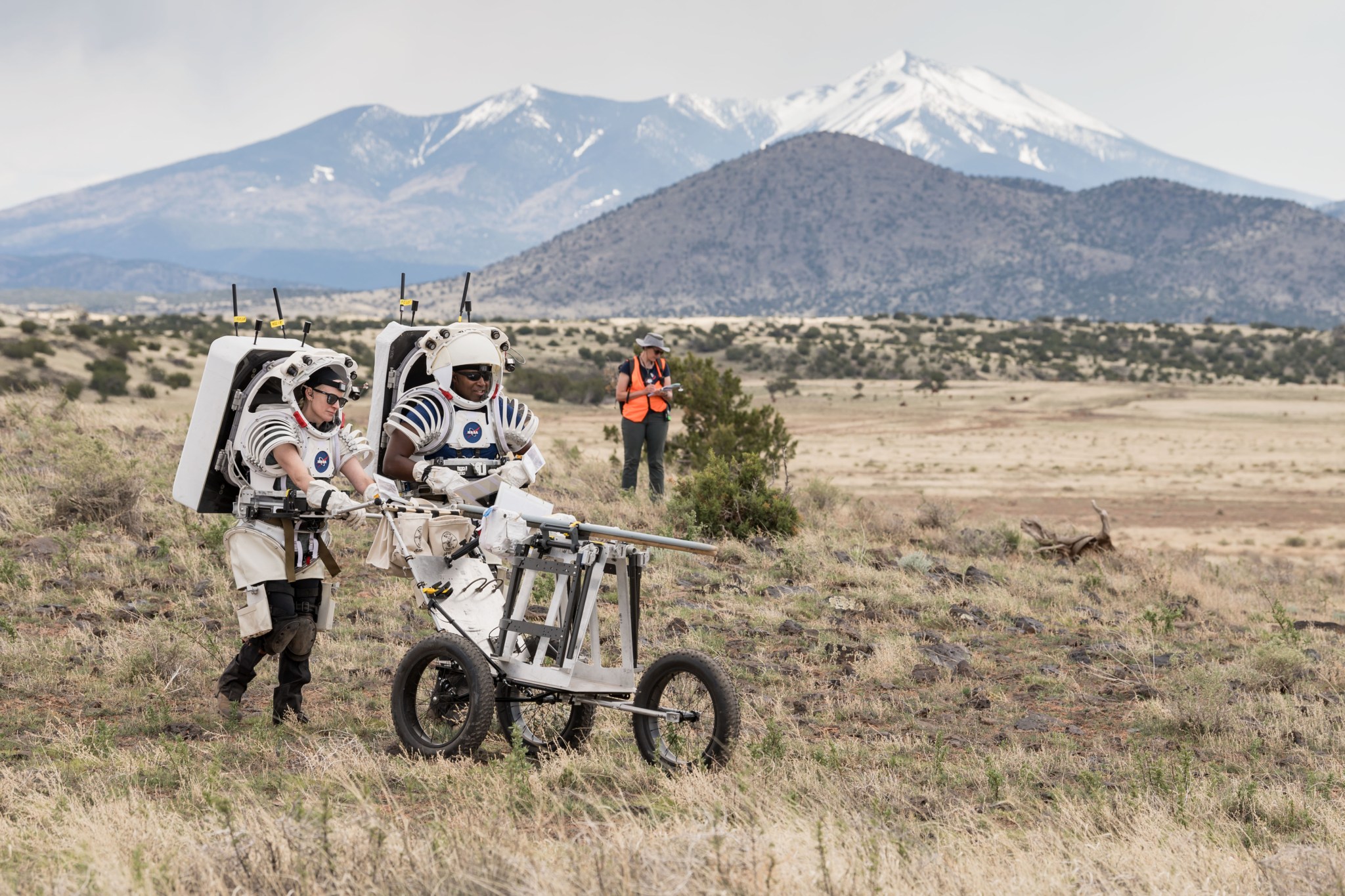NASA astronauts Kate Rubins and Andre Douglas push a tool cart loaded with lunar tools through the San Francisco Volcanic Field north of Flagstaff, Arizona, as they practice moonwalking operations for Artemis III.
NASA/Josh Valcarcel
To prepare for exploring the Moon during NASA’s Artemis campaign, the agency is conducting a week-long field test in the lunar-like landscape of San Francisco Volcanic Field near Flagstaff, Arizona to practice moonwalk scenarios.
NASA astronauts Kate Rubins and Andre Douglas are serving as the crewmembers and wearing mockup spacesuit systems as they traverse through the desert, completing a variety of technology demonstrations, hardware checkouts and Artemis science-related operations.
During the test, two integrated teams will work together as they practice end-to-end lunar operations. The field team consists of astronauts, NASA engineers, and field experts in the Arizona desert conducting the simulated moonwalks, while a team of flight controllers and scientists at NASA’s Johnson Space Center in Houston monitor and guide their activities.

NASA astronaut Kate Rubins observes a geology sample she collected during a simulated moonwalk.
NASA/Josh Valcarcel
“Field tests play a critical role in helping us test all of the systems, hardware, and technology we’ll need to conduct successful lunar operations during Artemis missions,” said Barbara Janoiko, director for the field test at Johnson. “Our engineering and science teams have worked together seamlessly to ensure we are prepared every step of the way for when astronauts step foot on the Moon again.”
The test consists of four simulated moonwalks that follow operations planned for Artemis III and beyond, as well as six advanced technology runs. During the advanced runs, teams will demonstrate technology that may be used for future Artemis missions, such as display and navigation data stream capabilities in the form of a heads-up display using augmented reality or lighting beacons that could help guide crew back to the lander.
Ahead of the field test, the science team at Johnson that was competitively selected and tasked with developing the science objectives for the field test, followed a planning process designed for Artemis missions. Their preparation included generating geologic maps, a list of science questions, and prioritized moonwalk locations for both the primary and back-up “landing sites” for the test.
“During Artemis III, the astronauts will be our science operators on the lunar surface with an entire science team supporting them from here on Earth,” said Cherie Achilles, science officer for the test at NASA’s Goddard Space Flight Center in Greenbelt, Maryland. “This simulation gives us an opportunity to practice conducting geology from afar in real time.”

NASA astronaut Andre Douglas collects soil samples during the first in a series of four simulated moonwalks in Arizona.
NASA/Josh Valcarcel
The test will evaluate gaps and challenges associated with lunar South Pole operations, including data collection and communications between the flight control team and science team in Houston for rapid decision-making protocols.
At the conclusion of each simulated moonwalk, the science team, flight control team, crewmembers, and field experts will come together to discuss and record lessons learned. NASA will take these lessons and apply them to operations for NASA’s Artemis missions, commercial vendor development, and other technology development.
This field test is the fifth in the series conducted by the Joint Extravehicular Activity and Human Surface Mobility Test Team led out of Johnson. This test expands on previous field tests the team has performed and is the highest fidelity Artemis moonwalk mission simulation to date.
NASA uses field tests to simulate missions to prepare for deep space destinations. The Arizona desert has been a training ground for lunar exploration since the Apollo era because of the many similarities to the lunar terrain, including craters, faults and volcanic features.
Through Artemis, NASA will land the first woman, the first person of color, and its first international partner astronaut on the Moon, paving the way for long-term lunar exploration and serving as a steppingstone for astronaut missions to Mars.

